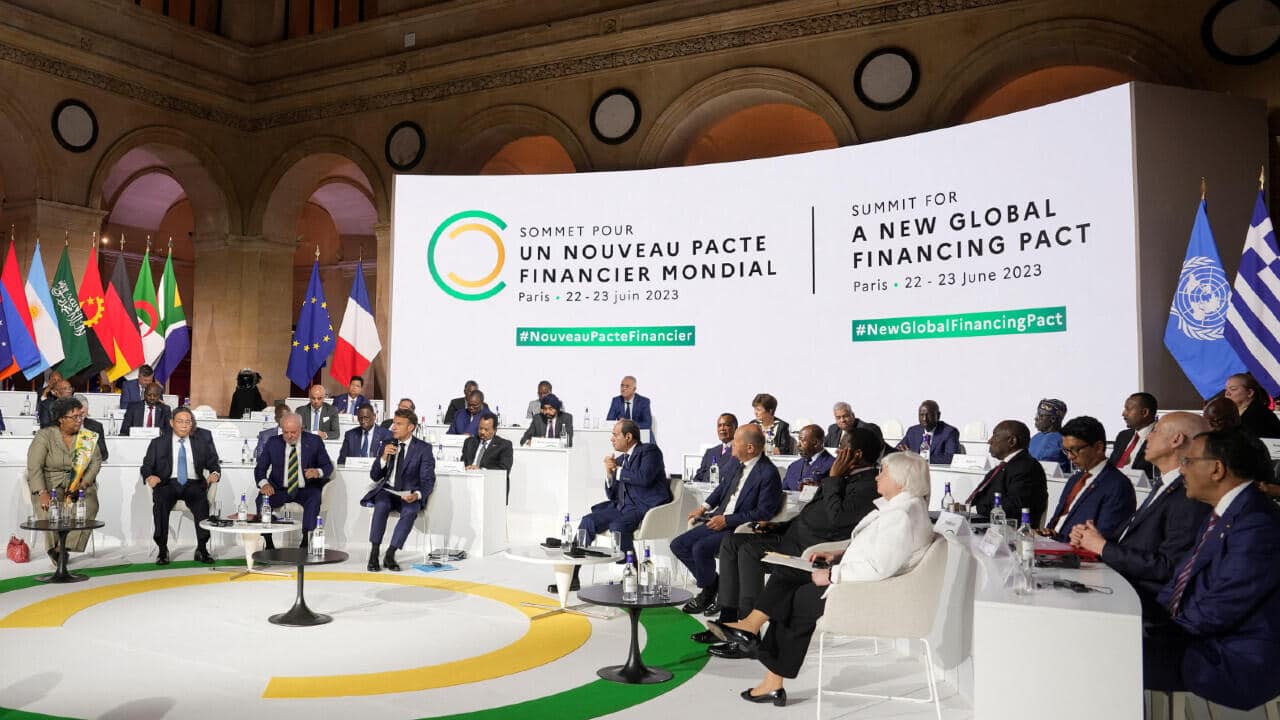[vc_row njt-role=”people-in-the-roles” njt-role-user-roles=”administrator,editor,author,armember”][vc_column][vc_column_text]
On June 22 and 23, the summit for a new global financial pact to reconcile the North and South was held in Paris. Addressing world leaders, Emmanuel Macron spoke of a “complete consensus” for “in-depth reform” of the global financial system, to make it “more efficient, fairer and better adapted to today’s world”. So, what’s in it for us?
For two days, some forty leaders from rich and emerging countries, as well as the most vulnerable states, gathered at the Palais Brongniart. Participants included Chinese Premier Li Qiang, South African President Cyril Ramaphosa and German Chancellor Olaf Scholz, the only G7 representative other than Emmanuel Macron. The aim of the summit, as advocated by the French President, was to overcome the divisions highlighted and amplified by the Russian invasion of Ukraine, by focusing on the diplomatic and financial aspects that require urgent attention.
Currently, fifty-three countries are facing or approaching high levels of indebtedness, and by 2021, the human development index has regressed in nine out of ten countries.
In fact, according to the NGO Oxfam, low- and middle-income countries will need $27,000 billion by 2030 to meet the costs of climate and social challenges. The $100 billion a year pledged since COP15 in Copenhagen in 2009, and finally raised this year for the first time, is not enough to be considered a victory.
A strategy of small steps
Despite the French President’s intentions to “profoundly reform” the global financial system, small but significant measures were adopted during the summit. For example, the World Bank recently announced its intention to include a new clause in its agreements with the most vulnerable countries, allowing debt payments to be suspended in the event of a natural disaster. Mia Mottley, the Prime Minister of Barbados in the Caribbean, is one of the main supporters of this measure.
The new President of the World Bank, Ajay Banga, has expressed his intention to transform the institution’s culture. At a press conference, he declared his desire to “measure the impact of this financing on greenhouse gas emissions” rather than focusing solely on the amount of financing. In concrete terms, this would mean adopting a global approach to the evaluation of financed projects, setting measurable objectives for the fight against climate change and the development of the countries concerned.
For South African President Cyril Ramaphosa, the nations of the South expect “not only a reform of the international financial architecture, but also that they translate into practical projects concerning infrastructure in particular”, he said. “It is on this condition that we Africans will be convinced that it is worth going to this kind of summit, going all the way to Europe and listening to all these promises”.
Senegal and Zambia at the heart of discussions
At the summit, Senegal established a “partnership for an equitable energy transition” with a group of Northern countries, including France, as well as multilateral development banks. The aim of this partnership is to achieve Senegal’s target of 40% renewable energy by 2030. This type of alliance had already been initiated in 2021 at COP26 in Glasgow, and has since enabled countries such as South Africa and Indonesia to make progress towards abandoning coal, a fossil fuel source with a high impact on greenhouse gas emissions.
Zambia’s creditors, notably China, have agreed to restructure a debt of $6.3 billion (around €5.8 billion), in response to the worsening indebtedness of several countries as a result of multiple crises. The decision comes more than two years after the country defaulted on its payments.
“We now have a method”, said Kristalina Georgieva, Managing Director of the International Monetary Fund (IMF). “I look forward to codifying Zambia’s case and then using it as a model for others.”
Follow-up mechanism
To conclude a final round table, Emmanuel Macron announced the creation of a follow-up mechanism for the commitments and discussions initiated in Paris. He invited the various players present to sign, if they so wished, the list of commitments discussed over the course of the two days. The French President also set a date for a follow-up report “every six months”. In addition, Emmanuel Macron expressed his wish to meet the participants again “in two years’ time”, just before COP25 in the Amazon, in order to assess the progress made as a result of this consensus.
This hybrid summit model was primarily conceived as a step towards bringing together the players in international negotiations in a more flexible framework than UN summits or G20 meetings. Sébastien Treyer, Director of the Institut du développement durable et des relations internationales, pointed out that the countries of the South seized this opportunity to make strong statements and coordinate their actions in preparation for forthcoming diplomatic meetings. For him, “this summit did not achieve all the hoped-for transformation of the system, but it should enable us to continue to pass on the baton and maintain the pressure in the months to come”.
Read also >Arab Summit: what was the outcome of the 32nd summit?
Featured photo : © Press[/vc_column_text][/vc_column][/vc_row][vc_row njt-role=”not-logged-in”][vc_column][vc_column_text]
On June 22 and 23, the summit for a new global financial pact to reconcile the North and South was held in Paris. Addressing world leaders, Emmanuel Macron spoke of a “complete consensus” for “in-depth reform” of the global financial system, to make it “more efficient, fairer and better adapted to today’s world”. So, what’s in it for us?
For two days, some forty leaders from rich and emerging countries, as well as the most vulnerable states, gathered at the Palais Brongniart. Participants included Chinese Premier Li Qiang, South African President Cyril Ramaphosa and German Chancellor Olaf Scholz, the only G7 representative other than Emmanuel Macron. The aim of the summit, as advocated by the French President, was to overcome the divisions highlighted and amplified by the Russian invasion of Ukraine, by focusing on the diplomatic and financial aspects that require urgent attention.
Currently, fifty-three countries are facing or approaching high levels of indebtedness, and by 2021, the human development index has regressed in nine out of ten countries.
In fact, according to the NGO Oxfam, low- and middle-income countries will need $27,000 billion by 2030 to meet the costs of climate and social challenges. The $100 billion a year pledged since COP15 in Copenhagen in 2009, and finally raised this year for the first time, is not enough to be considered a victory.
A strategy of small steps
Despite the French President’s intentions to “profoundly reform” the global financial system, small but significant measures were adopted during the summit. For example, the World Bank recently announced its intention to include a new clause in its agreements with the most vulnerable countries, allowing debt payments to be suspended in the event of a natural disaster. Mia Mottley, the Prime Minister of Barbados in the Caribbean, is one of the main supporters of this measure.
The new President of the World Bank, Ajay Banga, has expressed his intention to transform the institution’s culture. At a press conference, he declared his desire to “measure the impact of this financing on greenhouse gas emissions” rather than focusing solely on the amount of financing. In concrete terms, this would mean adopting a global approach to the evaluation of financed projects, setting measurable objectives for the fight against climate change and the development of the countries concerned.
For South African President Cyril Ramaphosa, the nations of the South expect “not only a reform of the international financial architecture, but also that they translate into practical projects concerning infrastructure in particular”, he said. “It is on this condition that we Africans will be convinced that it is worth going to this kind of summit, going all the way to Europe and listening to all these promises”.
Senegal and Zambia at the heart of discussions
[…][/vc_column_text][vc_cta h2=”This article is reserved for subscribers.” h2_font_container=”tag:h2|font_size:16|text_align:left” h2_use_theme_fonts=”yes” h4=”Subscribe now !” h4_font_container=”tag:h2|font_size:32|text_align:left|line_height:bas” h4_use_theme_fonts=”yes” txt_align=”center” color=”black” add_button=”right” btn_title=”I SUBSCRIBE !” btn_color=”danger” btn_size=”lg” btn_align=”center” use_custom_fonts_h2=”true” use_custom_fonts_h4=”true” btn_button_block=”true” btn_custom_onclick=”true” btn_link=”url:https%3A%2F%2Fluxus-plus.com%2Fen%2Fsubscriptions-and-newsletter-special-offer-valid-until-september-30-2020-2-2%2F”]Get unlimited access to all articles and live a new reading experience, preview contents, exclusive newsletters…
Already have an account ? Please log in.
[/vc_cta][vc_column_text]Featured photo : © Press[/vc_column_text][/vc_column][/vc_row][vc_row njt-role=”people-in-the-roles” njt-role-user-roles=”subscriber,customer”][vc_column][vc_column_text]
On June 22 and 23, the summit for a new global financial pact to reconcile the North and South was held in Paris. Addressing world leaders, Emmanuel Macron spoke of a “complete consensus” for “in-depth reform” of the global financial system, to make it “more efficient, fairer and better adapted to today’s world”. So, what’s in it for us?
For two days, some forty leaders from rich and emerging countries, as well as the most vulnerable states, gathered at the Palais Brongniart. Participants included Chinese Premier Li Qiang, South African President Cyril Ramaphosa and German Chancellor Olaf Scholz, the only G7 representative other than Emmanuel Macron. The aim of the summit, as advocated by the French President, was to overcome the divisions highlighted and amplified by the Russian invasion of Ukraine, by focusing on the diplomatic and financial aspects that require urgent attention.
Currently, fifty-three countries are facing or approaching high levels of indebtedness, and by 2021, the human development index has regressed in nine out of ten countries.
In fact, according to the NGO Oxfam, low- and middle-income countries will need $27,000 billion by 2030 to meet the costs of climate and social challenges. The $100 billion a year pledged since COP15 in Copenhagen in 2009, and finally raised this year for the first time, is not enough to be considered a victory.
A strategy of small steps
Despite the French President’s intentions to “profoundly reform” the global financial system, small but significant measures were adopted during the summit. For example, the World Bank recently announced its intention to include a new clause in its agreements with the most vulnerable countries, allowing debt payments to be suspended in the event of a natural disaster. Mia Mottley, the Prime Minister of Barbados in the Caribbean, is one of the main supporters of this measure.
The new President of the World Bank, Ajay Banga, has expressed his intention to transform the institution’s culture. At a press conference, he declared his desire to “measure the impact of this financing on greenhouse gas emissions” rather than focusing solely on the amount of financing. In concrete terms, this would mean adopting a global approach to the evaluation of financed projects, setting measurable objectives for the fight against climate change and the development of the countries concerned.
For South African President Cyril Ramaphosa, the nations of the South expect “not only a reform of the international financial architecture, but also that they translate into practical projects concerning infrastructure in particular”, he said. “It is on this condition that we Africans will be convinced that it is worth going to this kind of summit, going all the way to Europe and listening to all these promises”.
Senegal and Zambia at the heart of discussions
[…][/vc_column_text][vc_cta h2=”This article is reserved for subscribers.” h2_font_container=”tag:h2|font_size:16|text_align:left” h2_use_theme_fonts=”yes” h4=”Subscribe now !” h4_font_container=”tag:h2|font_size:32|text_align:left|line_height:bas” h4_use_theme_fonts=”yes” txt_align=”center” color=”black” add_button=”right” btn_title=”I SUBSCRIBE !” btn_color=”danger” btn_size=”lg” btn_align=”center” use_custom_fonts_h2=”true” use_custom_fonts_h4=”true” btn_button_block=”true” btn_custom_onclick=”true” btn_link=”url:https%3A%2F%2Fluxus-plus.com%2Fen%2Fsubscriptions-and-newsletter-special-offer-valid-until-september-30-2020-2-2%2F”]Get unlimited access to all articles and live a new reading experience, preview contents, exclusive newsletters…
Already have an account ? Please log in.
[/vc_cta][vc_column_text]Featured photo : © Press[/vc_column_text][/vc_column][/vc_row]



































